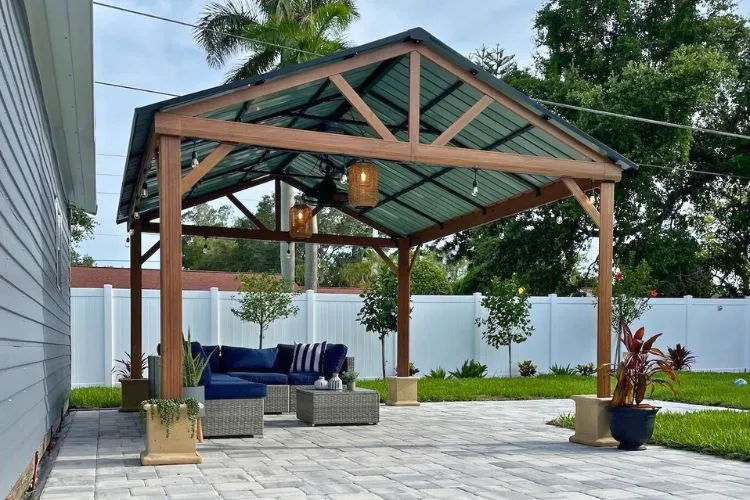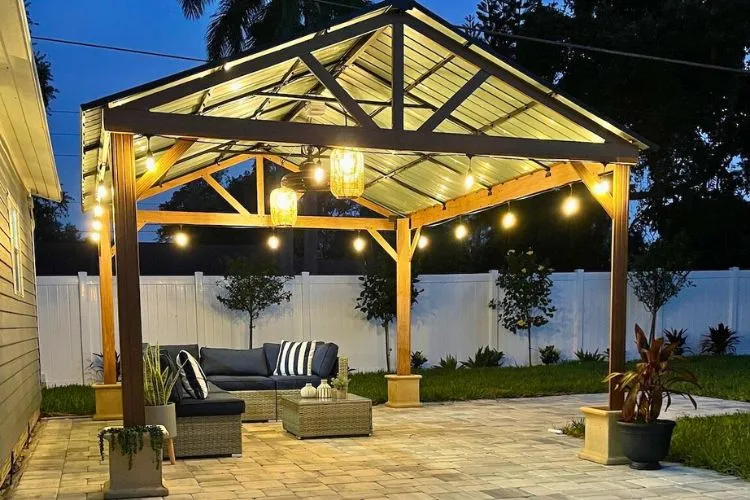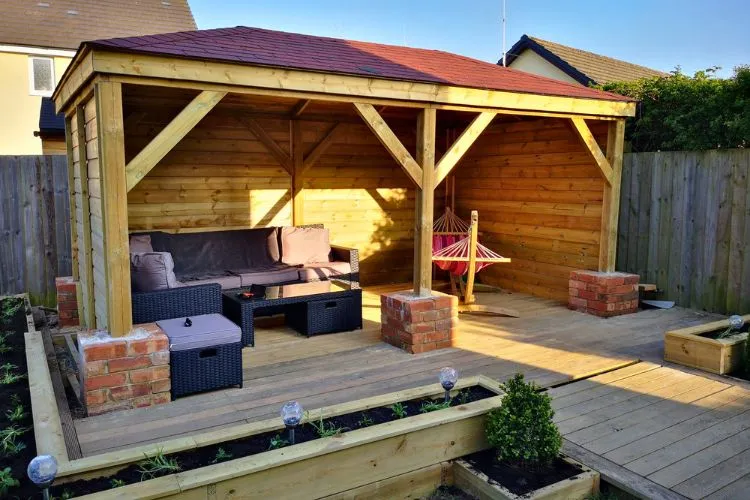Raising the height of a gazebo is a project many homeowners consider to enhance their outdoor space.
Whether for aesthetic appeal, to improve views, or to accommodate taller furnishings, understanding how to efficiently and safely increase your gazebo’s stature is critical.
This article provides a detailed guide on various methods to raise the height of a gazebo, along with essential tips and considerations.

Contents
Understanding the Need for Height Adjustment
Homeowners choose to raise the height of their gazebos for several reasons.
A higher gazebo can offer a better view of the surrounding landscape, allow for the inclusion of taller furniture or equipment, and improve airflow, making the outdoor space more comfortable in warmer months.
Recognizing your primary motivation for adjusting the gazebo’s height is the first step in planning a successful project.
How To Raise The Height Of A Gazebo?
Assessing the Gazebo Structure
Assessing your gazebo’s current structure is essential. This involves checking its stability and determining if it can support modifications for height increase.
Wooden gazebos require inspection for rot or insect damage, while metal structures should be checked for rust or structural weaknesses.
Obtaining Necessary Permissions
Before making any structural changes to your gazebo, it’s crucial to understand local building codes.
You may need to obtain permits or adhere to specific guidelines, ensuring your project complies with local regulations.
Methods to Raise Gazebo Height
There are several methods to consider when planning to raise your gazebo’s height.

Extending the Legs
One of the most straightforward methods is to extend the legs. This can be achieved using leg extensions or by mounting brackets designed to elongate the gazebo’s supports.
Alternatively, building new, taller legs to replace the existing ones can offer a more customized height adjustment.
Using durable materials and ensuring a seamless fit are key factors in successfully extending the legs.
Elevating the Entire Gazebo
Another option is to elevate the gazebo as a whole. Constructing a raised platform offers a stable base and can dramatically increase the height.
This method requires careful planning to ensure the platform’s stability and the gazebo’s secure attachment.
Adding a concrete or wooden base under each leg can also provide a minor height increase, suitable for those looking for a subtle change.
Step-by-Step Guide for Each Method
For extending the legs, you begin by removing any attached components such as stairways or ramps.
Afterward, carefully detach the gazebo from its current base. Using either manufactured extensions or newly built legs, securely attach each leg’s extension, ensuring they’re of equal length to avoid any tilt.
When elevating the entire gazebo onto a platform, start by constructing a solid and level base.
Materials like concrete or pressure-treated wood are advisable for their durability and resistance to weather. Securely fasten the gazebo onto the platform, checking for stability throughout the process.
Additional Considerations
Structural Integrity
Maintaining the gazebo’s structural integrity during and after height adjustment is crucial.
Every modification should enhance or, at the very least, not compromise stability. Regularly inspect the structure, especially immediately following modifications.

Aesthetic Implications
Raising a gazebo’s height can alter its appearance. It’s vital to plan for any necessary aesthetic adjustments.
This might include painting, staining, or adding decorative elements to ensure the gazebo remains an appealing feature in your outdoor space.
Weather Resistance
An elevated gazebo might face different weather challenges, especially wind.
Ensure your design includes considerations for wind resistance, such as securing the gazebo to its new base and possibly incorporating windbreaks into your landscaping.
Pro Tips
- Evaluate the feasibility of DIY projects versus professional implementation. Complex adjustments or significant height changes might require professional skills.
- Select materials that match or complement the existing gazebo and are suitable for outdoor use.
- Obtain all necessary permits to avoid legal issues and ensure your project meets local standards.
Maintenance and Care
After making adjustments to your gazebo, ongoing maintenance is essential to preserve its condition and ensure safety.
Regularly scheduled inspections are recommended, especially checking any new joints or extensions for wear or weakness.

It’s also vital to keep an eye on both wooden and metal parts. Wood components should be treated for weather resistance and checked for signs of rot or insect damage.
Metal parts require inspection for rust and corrosion. Promptly address any issues to prevent further damage.
Additionally, cleaning the gazebo and removing debris can also help maintain its appearance and functionality over time.
Frequently Asked Questions (FAQs)
Can I raise the height of any gazebo?
Not all gazebos are suitable for height adjustments. The material, structure, and condition of your gazebo will determine the feasibility of elevation changes.
How much does it cost to raise a gazebo’s height?
Costs vary widely based on the method used and whether you do it yourself or hire a professional. General estimates can range but expect to consider the cost of materials, any permits required, and labor if applicable.
Do I need a professional to raise my gazebo, or can I do it myself?
Simple adjustments might be within the capabilities of a DIY enthusiast. However, significant changes, especially those involving structural modifications, are best handled by professionals.
How can I ensure the raised gazebo is stable?
Ensuring stability involves carefully planning the height increase, using quality materials, and regularly inspecting the structure, particularly after severe weather.
Does raising the height of a gazebo require a new roof?
Not necessarily. If the adjustments are made to the legs or base, the existing roof can often be retained. However, significant alterations to the gazebo’s structure might necessitate roof adjustments or replacements.
Conclusion:
Raising the height of a gazebo can transform your outdoor living space, providing better views, improved airflow, and enhanced aesthetics.
By carefully planning the project, assessing the structure, obtaining necessary permits, and following detailed instructions for your chosen method, you can successfully increase your gazebo’s height.
With attention to maintenance and care, your elevated gazebo will continue to be a focal point of your outdoor space for years to come.

Sergio Gomes, a passionate advocate for outdoor living and the male voice behind Shades Authority. With years of experience, Sergio is your trusted source for expert insights on gazebos, pavilions, cabanas, pergolas, and all things outdoor shade solutions. Join him on a journey to transform your outdoor spaces into stunning, functional retreats
